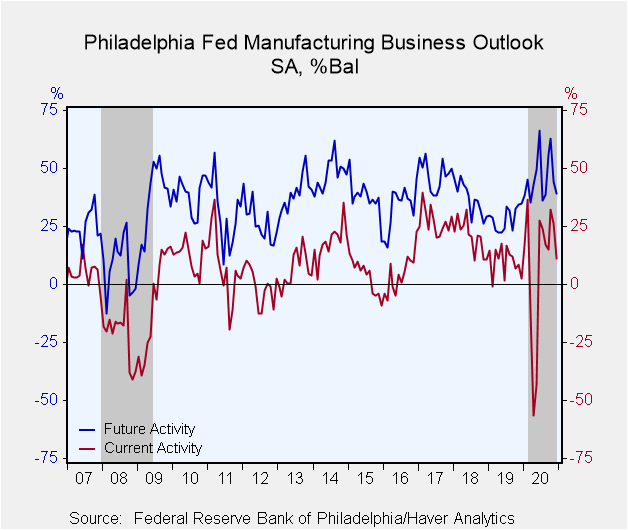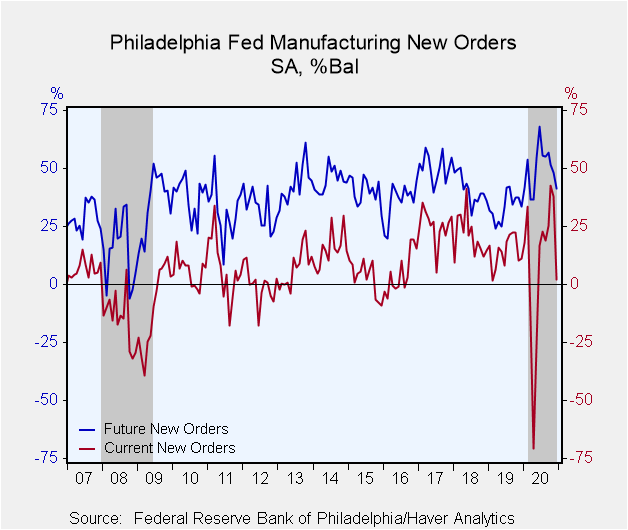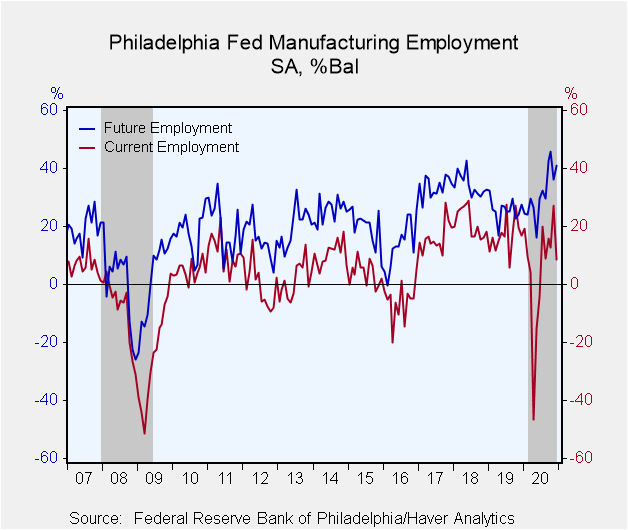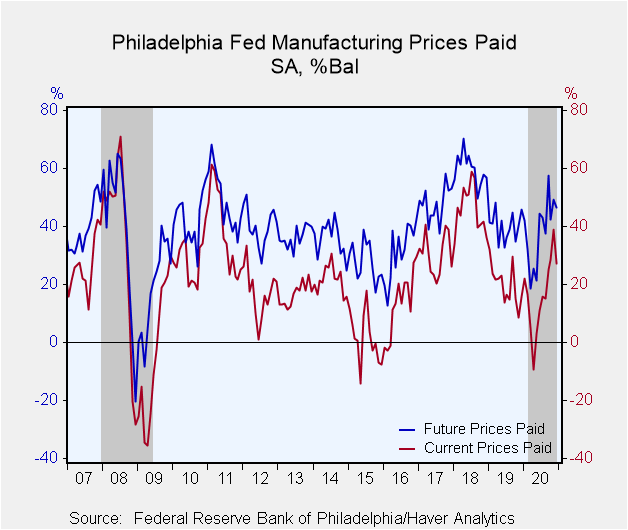 Global| Dec 17 2020
Global| Dec 17 2020Philly Fed Index Points to Significant Slowdown in December
by:Sandy Batten
|in:Economy in Brief
Summary
• Headline index falls 15 points to lowest level since spring low. • Component declines are broad-based. • Expectations mixed. The Federal Reserve Bank of Philadelphia reported that its General Factory Sector Business Conditions Index [...]
• Headline index falls 15 points to lowest level since spring low.
• Component declines are broad-based.
• Expectations mixed.
The Federal Reserve Bank of Philadelphia reported that its General Factory Sector Business Conditions Index has fallen to 11.1 in December from 26.3 in November. The index has now been in positive territory for seven consecutive months, indicating business expansion. However, the sharp decline in December points to a significant slowdown in the pace of activity. The Action Economics Forecast Survey expected a much smaller decline to 20.0. The percentage of firms reporting an improvement in business activity plummeted to 29% in December from 42% in November while the percentage reporting weaker conditions rose to 18% from 15%. Survey responses were collected between December 7 and December 14.
The headline index reflects the answer to a single question whereas the ISM index is calculated from five key components. Haver Analytics calculates an ISM-Adjusted General Business Conditions Index using the same underlying components that comprise the ISM index. This measure weakened to 54.8 from a near-record high 60.1 in November, but remains well above the 50 level that separates expansion from contraction.
The major component indexes generally fell in December but remained in positive territory. The new orders index plunged to 2.3 in December from 37.9 in November and 42.6 in October. 28.4% of respondents reported a decline in December, up markedly from 10.9% in November. The shipments index declined to 14.4 from 24.9 in November with 21.1% reporting a decline (vs. 15.9% in November). Unfilled orders slumped to 1.4 from 22.2. On the positive side, inventories rose to 10.3 from 1.8 and delivery times edged up to 18.5 from 18.0.
News was also weak on the labor front, with the employment index collapsing to 8.5 in December, its weakest reading since the spring, from 27.2% in November. The percentage of respondents reporting an increase in employment slumped to 18.3% in December from 34.0% in November. The average workweek index fell to 18.0 from 25.7 in November.
The index of prices paid fell to 27.1 in December from 38.9 in November, which was the highest level in two years. The percentage of respondents paying higher prices fell to 29.1% from 38.9% in November. The prices received index declined to 18.0 from 25.4 in November, which had been its highest level since February 2019.
The Philadelphia Fed also surveys expectations for business activity in six months. The Future Activity Index weakened for the second consecutive month to 39.2 from to 44.3 in November and 62.7 in October. Expectations for components were mixed with notable increases in shipments and employment.
The survey panel consists of 150 manufacturing companies in the third Federal Reserve District (which consists of southeastern Pennsylvania, southern New Jersey and Delaware). The diffusion indexes represent the percentage of respondents indicating an increase minus the percentage indicating a decrease in activity. The ISM-adjusted figure, calculated by Haver Analytics, is the average of five diffusion indexes: new orders, shipments, employment, delivery times and inventories with equal weights (20% each). Each ISM-adjusted index is the sum of the percent responding "higher" and one-half of the percent responding "no change."
The figures from the Philadelphia Federal Reserve dating back to 1968 can be found in Haver's SURVEYS database. The expectation from the Action Economics Forecast Survey is available in AS1REPNA.
| Philadelphia Fed - Manufacturing Business Outlook Survey (%, SA) | Dec | Nov | Oct | Dec'19 | 2019 | 2018 | 2017 |
|---|---|---|---|---|---|---|---|
| ISM-Adjusted Business Conditions | 54.8 | 60.1 | 61.5 | 55.4 | 55.5 | 57.7 | 57.2 |
| General Factory Sector Business Conditions | 11.1 | 26.3 | 32.3 | 2.4 | 9.9 | 20.9 | 27.3 |
| New Orders | 2.3 | 37.9 | 42.6 | 11.1 | 14.1 | 21.0 | 25.3 |
| Shipments | 14.4 | 24.9 | 46.5 | 15.7 | 16.9 | 22.8 | 26.7 |
| Unfilled Orders | 1.4 | 22.2 | 8.3 | 8.6 | 7.7 | 7.0 | 11.8 |
| Delivery Time | 18.5 | 18.0 | 20.5 | 12.5 | 9.4 | 9.5 | 10.6 |
| Inventories | 10.3 | 1.8 | -2.5 | 5.0 | 5.1 | 7.2 | 2.8 |
| Number of Employees | 8.5 | 27.2 | 12.7 | 16.8 | 16.9 | 21.5 | 16.1 |
| Average Workweek | 18.0 | 25.7 | 25.3 | 8.5 | 9.8 | 15.9 | 14.9 |
| Prices Paid | 27.1 | 38.9 | 28.5 | 15.9 | 19.7 | 46.1 | 30.4 |
| Expectations - General Business Conditions; Six Months Ahead | 39.2 | 44.3 | 62.7 | 34.8 | 28.4 | 36.8 | 47.1 |
Sandy Batten
AuthorMore in Author Profile »Sandy Batten has more than 30 years of experience analyzing industrial economies and financial markets and a wide range of experience across the financial services sector, government, and academia. Before joining Haver Analytics, Sandy was a Vice President and Senior Economist at Citibank; Senior Credit Market Analyst at CDC Investment Management, Managing Director at Bear Stearns, and Executive Director at JPMorgan. In 2008, Sandy was named the most accurate US forecaster by the National Association for Business Economics. He is a member of the New York Forecasters Club, NABE, and the American Economic Association. Prior to his time in the financial services sector, Sandy was a Research Officer at the Federal Reserve Bank of St. Louis, Senior Staff Economist on the President’s Council of Economic Advisors, Deputy Assistant Secretary for Economic Policy at the US Treasury, and Economist at the International Monetary Fund. Sandy has taught economics at St. Louis University, Denison University, and Muskingun College. He has published numerous peer-reviewed articles in a wide range of academic publications. He has a B.A. in economics from the University of Richmond and a M.A. and Ph.D. in economics from The Ohio State University.










